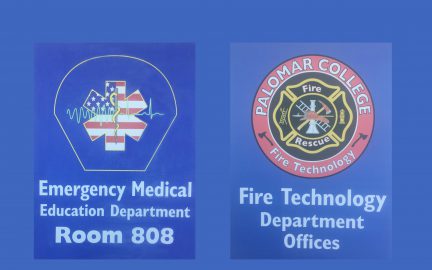| | | | |
| Program Requirements (21 Units) |
| FIRE 100: Fire Protection Organization | 3.0 | Spring 2025 | Spring 2025 | |
| FIRE 101: Firefighter Safety | 3.0 | Fall 2024, Spring 2025 | Fall 2024, Spring 2025 | |
| FIRE 118: Fire Prevention Technology | 3.0 | Fall 2024, Spring 2025 | | |
| FIRE 120: Building Construction for Fire Protection | 3.0 | Fall 2024, Spring 2025 | | |
| FIRE 130: Fire Protection Equipment and Systems | 3.0 | Fall 2024, Spring 2025 | | |
| FIRE 165: Fundamentals of Fire Protection Chemistry | 3.0 | Fall 2024, Spring 2025 | Fall 2024 | |
| FIRE 142: Fire Ethics | 3.0 | Spring 2025 | Spring 2025 | |
| Electives (Select 15 Units) |
| FIRE 51: Fire Academy Preparation | 3.0 | Fall 2024 | | |
| FIRE 98: Firefighter Skill Maintenance and Update | 1.5 | Fall 2024, Spring 2025 | | Must have completed an accredited Firefighter I Academy or Must have completed an approved internal Fire Department training program that follow State Fire Training 2013 standards for Firefighter I |
| FIRE 115: Hazardous Materials I | 3.0 | Fall 2024, Spring 2025 | | |
| FIRE 131: Introduction to Emergency Management | 3.0 | Fall 2024, Spring 2025 | | |
| FIRE 132: Disaster Response and Recovery | 3.0 | Spring 2025 | Fall 2024 | |
| FIRE 133: Disaster Mitigation | 3.0 | Fall 2024 | Spring 2025 | |
| FIRE 151: Fire Fighter I Academy | 20.0 | Fall 2024, Spring 2025 | | EME 106; Certification as an EMT-I; Admission to the Fire Fighter I Academy program. |
| FIRE 160: Wildland Fire Control I | 3.0 | Fall 2024, Spring 2025 | | |
| FIRE 171A: Company Officer 2A - Human Resource Management for Company Officers | 2.5 | Fall 2024, Spring 2025 | | Meet the educational requirements for Fire Fighter II or experience as a career or volunteer firefighter. |
| FIRE 171B: Company Officer 2B - General Administrative Functions for Company Officers | 1.0 | Fall 2024 | | Meet the educational requirements for Fire Fighter II or equivalent. |
| FIRE 171C: Company Officer 2C - Fire Inspections and Investigations for Company Officers | 2.5 | Fall 2024 | | Completion of a CA Regionally accredited Fire Academy or a signed statement the agency's Fire Chief or designee stating the sponsored student has completed all SFT training requirements and skills sheets for Fire Fighter I or equivalent. |
| FIRE 171D: Company Officer 2D - All Risk | 2.5 | Fall 2024 | | Completion of the following: ICS-200.B: Incident Command System for Single Resources and Initial Action Incidents Hazardous Material Incident Commander (as offered by the California Specialized Training Institute). |
| FIRE 171E: Company Officer 2E - Wildland Incident Operations | 2.5 | | | S-290 Intermediate Fire Behavior (Classroom Delivery Only). |
| FIRE 172A: Instructor I - Instructional Methodology | 2.5 | | | Recommended Preparation: Introduction to the Incident Command System (IS-100.B) or National Incident Management System (IS-700.A). |
| FIRE 180: Fire Prevention IA | 2.5 | | | |
| FIRE 181: Fire Prevention IB | 2.5 | | | |
| FIRE 194: Fire Instructor IB | 2.5 | | | |
| FIRE 197A: Fire Technology General Topics | 0.5 - 5.0 | | | |
| FIRE 197B: Fire Technology Command Topics | 0.5 - 5.0 | Fall 2024 | | |
| FIRE 197C: Fire Technology Filed Topics | 0.5 - 5.0 | | | |
| EME 106: Emergency Medical Technician (Lecture) | 6.0 | Fall 2024, Spring 2025 | | EME 105 with a minimum grade of B; Must be age 18 by the first day of class; Current American Heart Association CPR for BLS Provider or American Red Cross for the Health Care Provider. |
| CE 100: Cooperative Education | 0.5 - 4.0 | Fall 2024, Spring 2025 | | |
| FIRE 173: Legal Aspects of Emergency Services | 3.0 | | Fall 2024, Spring 2025 | |
 Air Conditioning, Heating and Refrigeration program is designed to provide students with the knowledge and hands-on-learning skills in the air conditioning and refrigeration industry. Applications of theory, principles and techniques will include system components and their interrelated functions, safety, procedures, tools and equipment to prepare the student for entry level employment in the HVAC field.
Air Conditioning, Heating and Refrigeration program is designed to provide students with the knowledge and hands-on-learning skills in the air conditioning and refrigeration industry. Applications of theory, principles and techniques will include system components and their interrelated functions, safety, procedures, tools and equipment to prepare the student for entry level employment in the HVAC field.





 Training to meet the requirements mandated by the California Office of State Fire Marshal for Certified Fire Fighter I. Covers fire ground procedures, tactics, strategy, safety methods, fire dynamics, equipment usage and deployment, and subject material pertaining to the role of fire fighters within the fire service.
Training to meet the requirements mandated by the California Office of State Fire Marshal for Certified Fire Fighter I. Covers fire ground procedures, tactics, strategy, safety methods, fire dynamics, equipment usage and deployment, and subject material pertaining to the role of fire fighters within the fire service.
 The Paramedic Program prepares the student in the elements of pre-hospital advanced life support. Upon successful completion of the program, the student is eligible to take the State of California EMT-P certification exam, which is the National Registry Emergency Medical Technician-Paramedic Exam.
The Paramedic Program prepares the student in the elements of pre-hospital advanced life support. Upon successful completion of the program, the student is eligible to take the State of California EMT-P certification exam, which is the National Registry Emergency Medical Technician-Paramedic Exam.


 Training to meet the requirements mandated by the California Office of State Fire Marshal for Certified Fire Fighter I. Covers fire ground procedures, tactics, strategy, safety methods, fire dynamics, equipment usage and deployment, and subject material pertaining to the role of fire fighters within fire services.
Training to meet the requirements mandated by the California Office of State Fire Marshal for Certified Fire Fighter I. Covers fire ground procedures, tactics, strategy, safety methods, fire dynamics, equipment usage and deployment, and subject material pertaining to the role of fire fighters within fire services.